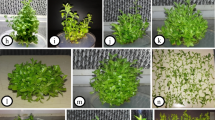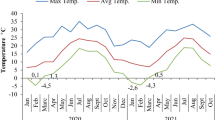Abstract
Conditions affecting rhizogenesis in vitro and ex vitro and subsequent acclimatisation of Telopea speciosissima (waratah) were investigated. Clonal selections were successfully rooted in vitro in agar, on filter paper bridges or using crushed quartz-sand, the last substrate resulting in superior growth of roots. The in vitro substrates were impregnated with half-strength MS, 7.5 gl-1 sucrose and various concentrations of IBA. For the quartz-sand, an IBA concentration of 50 μM was optimal, 70% of microcuttings were rooted. No plantlets rooted in vitro were acclimatised to ex vitro conditions (using mist, fog or humidity tent regimes). Microcuttings (25–45 mm in length) were rooted ex vitro in a fog humidity regime (droplet size <10 μm) using an IBA powder dip (3 g IBA kg-1). Neither a mist nor a humidity-tent regime was suitable for rooting of waratah microshoots ex vitro. A peat and perlite mixture was superior to crushed quartz-sand or potting mix for the rooting of microshoots; this appeared to be related to the air-filled porosity (>20%) of the mixture, measured after the medium was saturated and then drained for 24h. Plantlets must be left under the high humidity regime until shoot growth resumes (four to eight weeks) otherwise plant mortality increase significantly. In vitro-produced leaves abscised between eight and 12 weeks after transfer to ex vitro conditions, indicating that these structures did not acclimatise ex vitro.
Similar content being viewed by others
Abbreviations
- BA:
-
benzyladenine
- GA3 :
-
gibberellic acid
- IBA:
-
indole-3-butyric acid
- LSD:
-
least significant difference
- MS:
-
Murashige and Skoog medium
References
Aitken R (1985) Propagation by cuttings. In: Lamont BB & Watkins PA (Eds) Horticulture of Australian Plants (pp 32–37). Western Australian Dept. Agriculture, Perth
Aldrufeu A, Pages M, Messeguer J & Mele E (1983) In vitro rhizogenesis in different substrates. Acta Hort. 150: 315–323
Bhojwani SS, Mullins K & Cohen D (1987) Micropropagation of Feijoa sellowiana Berg. Acta Hort. 212: 69–76
Brand MH & Lineberger RD (1986) In vitro propagation of Halesia carolina L. and the influence of explantation of initial shoot proliferation. Plant Cell Tiss. Org. Cult. 7: 103–113
Briggs B (1987) Commercial production of ericaceous plants by tissue culture. Acta Hort. 212: 644
Desjardins Y, Laforge F, Lussier C & Gosselin A (1988) Effect of CO2 enrichment and high photosynthetic photon flux on the development of autotrophy and growth of tissue cultured strawberry, raspberry and asparagus plants. Acta Hort. 230: 45–53
Donnelly DJ & Vidaver WE (1984) Pigment content and gas exchange of red raspberry in vitro and ex vitro. HortScience 109: 177–181
Donnelly DJ, Vidaver WE & Colbow K (1984) Fixation of CO2 in tissue cultured red raspberry prior to and after transfer to soil. Plant Cell Tiss. Org. Cult. 3: 313–317
Fujiwara K, Kozai T & Watanabe I (1988) Development of a photoautotrophic tissue culture system for shoots and/or plantlets at rooting and acclimatisation stages. Acta Hort. 230: 153–158
Grout BWW & Millam S (1985) Photosynthetic development of micropropagated strawberry plantlets following transplanting. Ann. Bot. 55: 129–131
Handreck KA & Black ND (1989) Growing media for ornamental plants and turf. Second edition, University of New South Wales Press, Sydney
McClelland MT & Smith MAL (1988) Response of woody plant microcuttings to in vitro and ex vitro rooting methods. Comb. Proc. Intl. Plant Prop. Soc. 38: 593–599
Macdonald AB (1985) Propagation facilities-past and present. Comb. Proc. Intl. Plant Prop. Soc. 36: 170–175
Maene LM & Debergh PC (1983) Rooting of tissue cultured plants under ex vitro conditions. Acta Hort. 131: 201–208
Marin JA & Gella R (1987) Acclimatisation of the micropropagated cherry rootstock ‘Masto de Montanana’ (Prunus cerasus L.). Acta Hort. 212: 603–606
Murashige T (1984) Plant propagation through tissue culture. Annu. Rev. Plant Physiol. 25: 135–166
Murashige T & Skoog F (1962) A revised medium for rapid growth and bioassays with tobacco tissue cultures. Physiol. Plant. 15: 473–497
Noiton D (1988) Adventitious root formation in the apple. PhD thesis, University of Sydney, Sydney
Offord CA, Campbell LC & Mullins MG (1992) Micropropagation of Telopea speciosissima R. Br. (Proteaceae). 1. Explant establishment and proliferation. Plant Cell Tiss. Org. Cult. (in press)
Press TF (1983) Propagation: fog not mist. Comb. Proc. Intl. Plant Prop. Soc. 33: 100–109
Purnell HM (1960) Studies of the family Proteaceae. 1. Anatomy and morphology of the roots of some Victorian species. Austral. J. Bot. 8: 38–50
Simmonds J (1983) Direct rooting of micropropagated M26 apple rootstock. Scientia Hort. 21: 233–241
Sutter E (1983) Micropropagation of mature ortets of Liquidambar styraciflua. HortScience 18: 103
Sutter E, Novello V & Shakel K (1988) Physiological and anatomical aspects of water stress of cultured plants. Acta Hort. 230: 113–119
Walker N, Jaques R & Miginiac E (1987) Action of light on rooting in vitro and acclimatisation of Sequoia sempervirens to soil. Acta Hort. 212: 289–301
Author information
Authors and Affiliations
Rights and permissions
About this article
Cite this article
Offord, C.A., Campbell, L.C. Micropropagation of Telopea speciosissima R. Br. (Proteaceae). 2: Rhizogenesis and acclimatisation to ex vitro conditions. Plant Cell Tiss Organ Cult 29, 223–230 (1992). https://doi.org/10.1007/BF00034356
Received:
Accepted:
Issue Date:
DOI: https://doi.org/10.1007/BF00034356




